The LISA project to measure gravitational waves seems like science fiction

The European Space Agency (ESA) has approved the development of the Laser Interferometer Space Antenna (LISA). Three satellites with lasers arranged in a triangle will create a constellation on Earth that will open a new stage in the study of gravitational waves from space.
The LISA project stalled for three decades. This year, ESA acknowledged that it has sufficiently advanced technology to achieve this goal. When the process is complete, scientists will install an acoustic receiver that will accompany the Earth for a year on the basis of three spacecraft located at a distance of 2.5 million kilometers from each other.
The antenna will detect gravitational waves with greater accuracy and sensitivity than the current Laser Interferometer Gravitational Wave Observatory (LIGO) located in the US. The signals are disturbances in space-time that travel at the speed of light as a result of extremely violent events in the universe, such as the collision of two black holes. Albert Einstein’s theory of general relativity predicted these waves and 100 years later they were confirmed at LIGO.
Here’s how the Laser Interferometer Space Antenna (LISA) works
LISA will detect the waves by sending laser signals between devices. Carsten Danzmann, director of the Max Planck Institute for Gravitational Physics in Hanover, Germany, explains that the LISA probes are capable of measuring the distance of the light arc to within billionths of a meter. If some strong event destroys the fabric of space-time, the laser power will undergo noticeable changes and the origin of the wave will become known.
Detectors on Earth, such as LIGO, must contend with the planet’s internal motions and other cosmic disturbances. In the vacuum of space, antennas will not move due to shocks or atmospheric conditions. To increase sensitivity, each ship will be equipped with a 4.6-centimeter floating cube made of gold and platinum. This ensures the localization of gravitational waves with wavelengths from 300 thousand to three billion kilometers. This scale consists of the longest ones detected by LIGO and the shortest ones detected by pulsar timing arrays.
The space antenna will explore the nature of the Universe through acoustic waves. Therefore, its mission goes beyond its detection. According to the project’s official portal, he will have to study the formation of binary star systems, track the evolution of black holes, explore the dynamics of incredibly massive star clusters, explore the fundamental nature of gravity and, finally, listen to the course on which the Universe is expanding.
Listen to the universe to give it a new dimension
The LISA project represents a different way of understanding the space environment. Until now, astronomical knowledge has been based on the capture of visible light and its variants, such as infrared or X-rays. measure dark matter. “Combining this with the detection of gravitational waves opens up a whole new dimension in our perception of the Universe,” explains Oliver Jennrich, LISA project scientist.
ESA says construction of the probes will begin in 2025, with their launch to take place sometime in 2035. At the moment, the leadership of the space agency is looking for a contractor who will implement a space antenna with a laser interferometer.
“If we imagine that in our astrophysics missions so far we have observed space as a silent movie, then capturing the ripples of spacetime with LISA will be a real game-changer, just like when sound was added to movies. – Jenrich finished.


